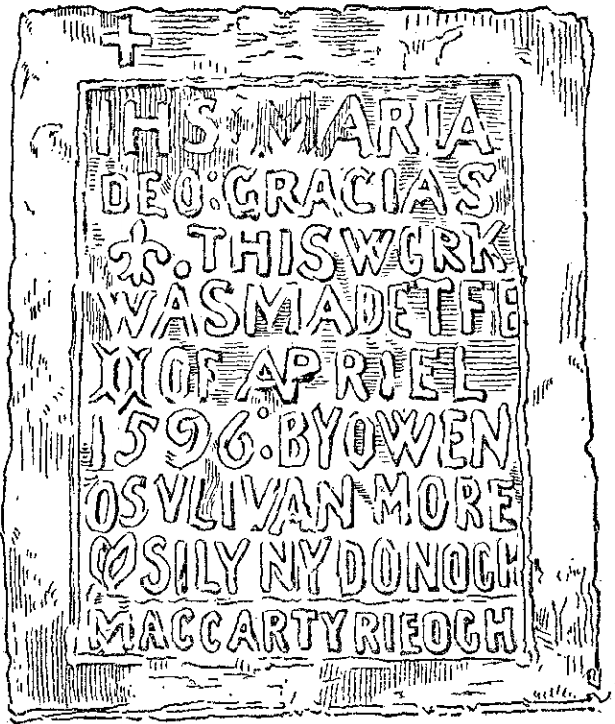Dunkerron Castle on:
[Wikipedia]
[Google]
[Amazon]
Dunkerron Castle () is a ruined four-storey

tower house
A tower house is a particular type of stone structure, built for defensive purposes as well as habitation. Tower houses began to appear in the Middle Ages, especially in mountainous or limited access areas, in order to command and defend strateg ...
located in Templenoe
Templenoe () is a civil parish in County Kerry, Ireland. It is situated four miles from Kenmare, on the N70 road to Sneem, which forms part of the Ring of Kerry.
Templenoe is the location of the Ring of Kerry golf club. There is a Gaelic Athle ...
, near Kenmare
Kenmare () is a small town in the south of County Kerry, Ireland. The name Kenmare is the anglicised form of ''Ceann Mara'', meaning "head of the sea", referring to the head of Kenmare Bay.
Location
Kenmare is located at the head of Kenmare ...
, County Kerry
County Kerry ( gle, Contae Chiarraí) is a county in Ireland. It is located in the South-West Region and forms part of the province of Munster. It is named after the Ciarraige who lived in part of the present county. The population of the co ...
, in south-west Ireland
Ireland ( ; ga, Éire ; Ulster Scots dialect, Ulster-Scots: ) is an island in the Atlantic Ocean, North Atlantic Ocean, in Northwestern Europe, north-western Europe. It is separated from Great Britain to its east by the North Channel (Grea ...
. The castle was the family seat
A family seat or sometimes just called seat is the principal residence of the landed gentry and aristocracy. The residence usually denotes the social, economic, political, or historic connection of the family within a given area. Some families to ...
of the O'Sullivan Mór family from the late 16th century.
History
The four-storey tower house was built in the 13th century on a limestone outcrop as aNorman
Norman or Normans may refer to:
Ethnic and cultural identity
* The Normans, a people partly descended from Norse Vikings who settled in the territory of Normandy in France in the 10th and 11th centuries
** People or things connected with the Norm ...
( Carew) stronghold. Several later structures of the castle, including an enclosed court, date to the late 16th century, when Owen O'Sullivan became 'Chief of the Name
The Chief of the Name, or in older English usage Captain of his Nation, is the recognised head of a family or clan (''fine'' in Irish and Scottish Gaelic). The term has sometimes been used as a title in Ireland and Scotland.
In Ireland
In Eliza ...
' and acceded to the title of 'O'Sullivan Mór'. An inscribed plaque, dated 1596, recorded the castle's association with the O'Sullivan Mór and MacCarthy Reagh
The Mac Cárthaigh Riabhach (anglicised ''MacCarthy Reagh'') dynasty are a branch of the MacCarthy dynasty, Kings of Desmond, deriving from the Eóganacht Chaisil sept.
History
The Mac Cárthaigh Riabhach seated themselves as kings of Carbery in ...
dynasties. The castle was the family seat
A family seat or sometimes just called seat is the principal residence of the landed gentry and aristocracy. The residence usually denotes the social, economic, political, or historic connection of the family within a given area. Some families to ...
of the O'Sullivan Mór for some time.
The main O'Sullivan Mór familial seat moved to nearby Cappanacush Castle during the 17th century, and antiquary Samuel Lewis noted that both castles were "traditionally said to have been defended" by their O'Sullivan Mór owners during the mid-17th century Cromwellian conquest of Ireland
The Cromwellian conquest of Ireland or Cromwellian war in Ireland (1649–1653) was the re-conquest of Ireland by the forces of the English Parliament, led by Oliver Cromwell, during the Wars of the Three Kingdoms. Cromwell invaded Ireland wi ...
. The O'Sullivan castles and lands at Dunkerron and Cappanacush were confiscated following this conflict under the Act for the Settlement of Ireland 1652
The Act for the Setling of Ireland imposed penalties including death and land confiscation against Irish civilians and combatants after the Irish Rebellion of 1641 and subsequent unrest. British historian John Morrill wrote that the Act and ...
, and assigned to Cromwellian supporter William Petty
Sir William Petty FRS (26 May 1623 – 16 December 1687) was an English economist, physician, scientist and philosopher. He first became prominent serving Oliver Cromwell and the Commonwealth in Ireland. He developed efficient methods to su ...
. Later O'Sullivan attempts to have the lands returned were not successful.
By the 19th century, maps record the castle and court as being "in ruins", and a Victorian manor house, Dunkerron House, was built on the estate around that time.

Title
One of the last members of a branch of the O'Sullivans was Donal O'Sullivan, who died on 16 April 1754, without issue or heirs. The title he bore, the "Prince of Dunkerron", became extinct on his death. The British monarchy did issue a peerage title ofBaron Dunkeron
Baron is a rank of nobility or title of honour, often hereditary, in various European countries, either current or historical. The female equivalent is baroness. Typically, the title denotes an aristocrat who ranks higher than a lord or knig ...
to John Petty. (John Petty was Sheriff of Kerry from 1732, and a descendant of the William Petty to whom the lands had been given following the Cromwellian confiscations). The title assigned to Petty was not however related to the original title of the native Irish nobility
The Irish nobility could be described as including persons who do, or historically did, fall into one or more of the following categories of nobility:
* Gaelic nobility of Ireland descendants in the male line of at least one historical grade o ...
.
References
{{Historic Irish houses, state=collapsed Castles in County Kerry Ruined castles in Ireland